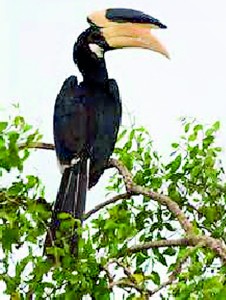My village by the jungle
The magnificent Bo Tree (Ficus religiosa) in the centre of the land was the deciding factor in my buying a homestead with a few small buildings in Samagipura Mahabulankulama off the Puttalam Anuradhapura road.
The few acres of land are settling into a garden while the buildings have become the first part of a house. Not being a village in the traditional manner, the houses in the area are set in two acre blocks of land. Cultivation within the two major constrictions of

Home in the jungle: A place to watch the village go by
marauding wild elephants and seasonal lack of water goes on. Most of the village residents are gainfully employed outside the perimeters of the village. As a result the villagers are not in poverty.
How life sustaining a Bo Tree is in its natural state is truly a wonder. Life seems to be drawn to and emanate from this majestic tree while tranquility surrounds it. Do the marauding elephants feel this energy as they pass by the tree? I am not sure for they visit by night and the impressions of their feet like large plates on the ground are evidence of visits left for the morning.
A pair of giant squirrels live in the tree and when I first visited my house and circled the tree, they came to almost touching distance to stare at me and check me out. Many of the birds drawn to the garden do find time to get to the tree, the largest and most startling of them the Malabar Pied Hornbills which come in numbers but seasonally. The largest of our birds Peafowl (Pavo cristatus) abound but are not drawn to the Bo. They are God Kataragama’s chosen vehicle by legend whose raucous and penetrative cry heard throughout the day, is supposed to keep away evil spirits.
Just as well for the row of white frangipani, plumaria, temple flower, or araliya trees in front of the land are supposed to harbour spirits. The beautiful colours of the peacocks never cease to amaze me, beauty and grace with such dignity laced with arrogance is what I see in every peacock though I have seen thousands over the years both captive in our own family homes and free in the wilds.
Our national bird the Jungle Fowl (Gallus lafayetti) fills the daytime with its abrupt two word sound described by British colonials as ‘George Joyce’. From its flame-like comb, curving tail feathers and spurs on its feet this relatively small fowl is again more colourful in the male form. The hens are rather drab like the peahens.
The sounds of the day dominated by a bird choir, if one may call it that, gives way by night to another set of vocalists when sounds of the insects and in the rains, the frogs dominate. The elephants, hare and other nocturnal mammals are mostly silent as they visit. I have not heard the high pitched howl of the jackal or the twitter of the otter in this place nor is there evidence of their visits. Mongoose I have seen in the day but the fishing, Jungle and rusty spotted cat have remained elusive. No evidence of leopard presence at all, nor  talk of it.
talk of it.
The range of jungle trees in the compound, large and still growing, offer refuge to a vast array of birds. Alexandrines our largest parrot and the Imperial Rock Pigeon our largest pigeon share space with Ring-necked Parrots and Wood Pigeons. Ash Doves walk on ground but no Ring necked Doves are to be seen. The list goes on to little Minivets, Bee eaters, Woodpeckers and Kingfishers ’Redi horas’, ‘Malkohas’, Gini Horas and some birds my Kandyan Hill upbringing cannot identify.
There are scurrying iguanas, skinks and garden lizards, but no slow and measured chameleons. The occasional Russels Viper and cobra with whom I do not wish to get intimate nor any other of the snakes one sees though rarely.
The cacophony of nightsounds which emanates mostly from insects is incredible and somehow soothing. That such small creatures can collectively create so much sound and in harmony is thought provoking. The elegant Praying Mantis is probably the most serene and least troubling, for the night air gets filled not only with the sounds but also the actual presence of different species of insects in very large numbers, making sitting out on the verandah virtually impossible by night. Scorpions brought out by the rains are only a point of interest.
For me however by far the most attractive of all remains the people. As life swirls around, the atmosphere of village life is still preserved. Lounging in an armchair as I watch life go by I am reminded of my grandfather’s house in Kuliyapitiya and what could truly be termed a lifestyle. Everything has fallen back into place after so many big cities and capitals of the world for me, the visible much higher standards of the villagers manifested in proper houses, better clothes, motor bicycles, tractors, trucks- a cause for satisfaction.
As society in this upward mobile village goes forward in its vibrant, strong, educated youth I know I can continue to lounge, for my country is on its way to great things. The people – the driving force are quite unstoppable.


